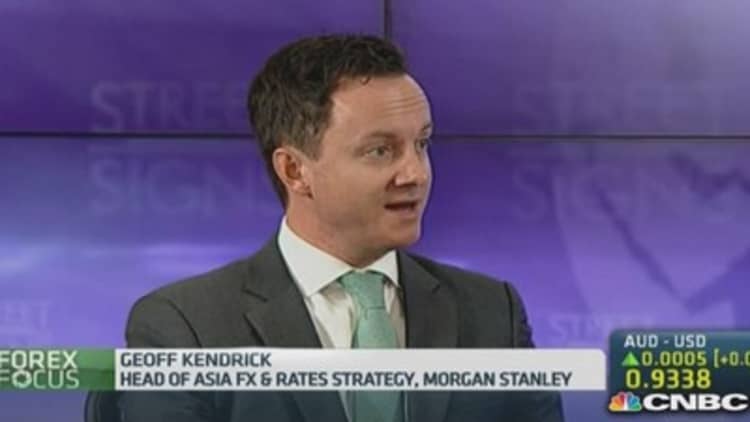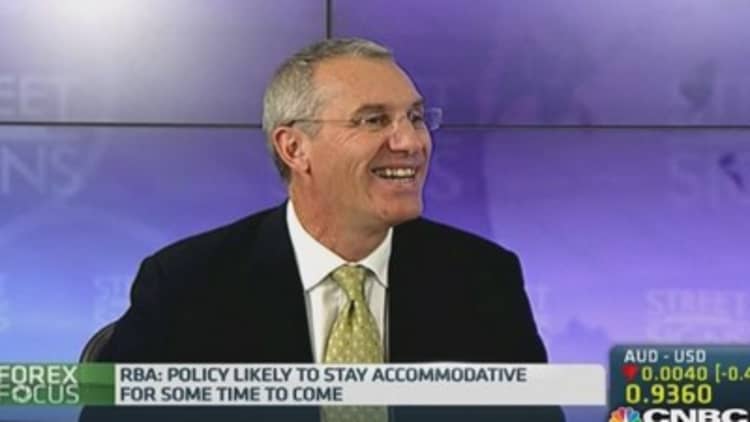
The Australian dollar has stubbornly resisted broad expectations it would weaken, and now some bears are starting to step away from their calls.
Goldman Sachs advises investors in Australia's stock market should buy options to protect against the risk the Australian dollar may continue to hover around current levels, which would weigh on earnings.
"While our view is that Australian growth will trend down and that the RBA (Reserve Bank of Australia) will cut rates again (25bp in September), the extension of loose monetary policy by global central banks and ongoing Chinese reserve diversification remain the biggest risks to our bearish Australian dollar view," Matthew Ross, head of portfolio strategy for Goldman Sachs in Australia, said in a note Tuesday.
Read More Why Australia shares have stalled
The stars appear to be aligned for a bearish view on the currency. Ross noted that a weaker Australian dollar is a consistent call among sell-side analysts, with the economy set for sub-trend growth as the mining sector is becoming a drag as commodity prices fall. In addition, the housing sector's peak contribution is behind it and consumer reaction to a harsh federal budget has been negative, Ross said.
Instead, the Australian dollar has climbed over 4.5 percent against the U.S. dollar so far this year.
Even the RBA keeping interest rates at a record low 2.5 percent since August and Governor Glenn Stevens trying to talk the currency down last year by saying he would like it trading at $0.85 hasn't been able to sink the Australian dollar.
Read More Australia's AAA rating: Should it stay or go?
This is likely to put the stock index at risk, Ross said.
"If the Australian dollar stays at year-to-date highs we would expect to see currency-related earnings downgrades in coming months," Ross said, adding that around a third of the revenues of ASX 200 companies are in other currencies. "The impact to already weak earnings growth would be significant."
Goldman has a 12-month forecast for the Australian dollar to fall to around $0.80; it was at $0.9336 in Asian trade Wednesday. It has struck in an around $0.92-$0.94 range since the end of March.
The expectation for the currency to weaken may be broad-based, but it isn't clear what may be left to drive it down.
Read More This could worsen Australia's skilled worker shortage
All the negatives -- weaker commodity prices, a stronger U.S. dollar, slowing China growth and low RBA interest rates -- have been well-known in the market since the start of the year, noted Jonathan Cavenagh, senior foreign-exchange strategist at Westpac Bank.

Although Westpac still expects the currency to fall to $0.90 by year end, $0.85 is likely "too hard," he said.
"The fundamental backdrop suggests it should be lower, but in a global context, [it's hostage to] other central banks," Cavenagh said, noting the Federal Reserve is still expanding its balance sheet, albeit at a slower pace, and the European Central Bank (ECB) now has a negative deposit rate.
"Even though interest rates in Australia are low, there is still that appeal from the yield that is supporting the Australian dollar," Cavanagh said.
Read More The Aussie at parity by year-end?
Some are even calling for the Australian dollar to rise, possibly heading for parity with the U.S. dollar.
"Foreign-exchange flows are now very positive in Aussie's favor," Geoff Kendrick, head of Asian foreign exchange and interest rate strategy at Morgan Stanley, told CNBC. He expects the Australian dollar will hit parity with the U.S. dollar by year end.
"The global backdrop remains one of very muted volatility. So investors in Japan in particular are starting to reach for yield again," Kendrick said, noting non-residents bought as much as $11 billion of Australian government debt in the first quarter."2.5 percent at the cash rate or 3.8 percent at the 10-year (Australian government bond) is pretty attractive when Australian debt remains one of the few AAAs out there."
—By CNBC.Com's Leslie Shaffer; Follow her on Twitter @LeslieShaffer1

